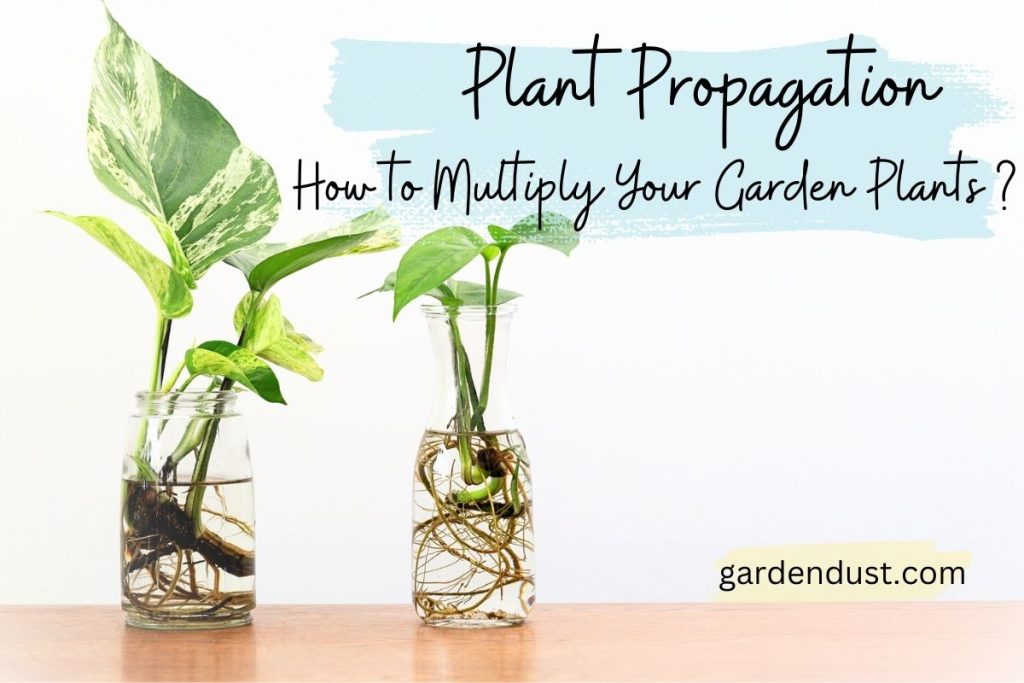Plant propagation is the process of multiplying a plant by any means other than seed. This can be done using several methods such as stem cuttings, leaf cuttings, root cuttings, division, layering, and grafting. With the right technique and a bit of patience, you can propagate many of your favorite garden plants and multiply them to increase your garden’s beauty and abundance.
How to Multiply Your Garden Plants?
Methods of Propagation
1.Stem Cuttings

Stem cuttings are a simple and effective way to propagate a wide range of plants such as herbs, shrubs, and trees. Cuttings can be taken from the tips, middle or bottom of a stem. Use a clean and sharp pair of pruning shears to make a clean cut at a 45-degree angle. Remove any leaves from the bottom of the cutting and dip the cut end into rooting hormone powder. Place the cutting into a pot filled with a well-draining potting mix and water thoroughly. Place the pot in a bright and warm location, but avoid direct sunlight. Mist the cutting regularly and keep the soil moist until roots develop, which can take several weeks to a few months. You can put stem into water after few days roots will start.
2.Leaf Cuttings

Leaf cuttings are a simple way to propagate succulents, such as jade plants and snake plants. Select a healthy leaf and gently twist it off the stem. Let the leaf dry for a day or two until the cut end has calloused over. Plant the cut end of the leaf into a pot filled with a well-draining potting mix and water thoroughly. Place the pot in a bright and warm location, but avoid direct sunlight. Mist the soil regularly and keep it moist until new growth emerges, which can take several weeks to a few months. Putting into water also gives a good result.
3.Root Cuttings

Root cuttings are a great way to propagate perennials such as coneflowers and irises. Dig up a mature plant and cut several healthy roots into sections that are about 2 inches long. Plant each section in a pot filled with a well-draining potting mix and water thoroughly. Place the pot in a bright and warm location, but avoid direct sunlight. Keep the soil moist until new growth emerges, which can take several weeks to a few months.
4.Division

Division is a common method for propagating plants that form clumps such as hostas and daylilies. Dig up the clump and separate it into smaller sections using a sharp knife or spade. Each section should have a good portion of roots and several stems or shoots. Plant each section in a pot filled with a well-draining potting mix and water thoroughly. Place the pot in a bright and warm location, but avoid direct sunlight. Keep the soil moist until new growth emerges, which can take several weeks to a few months.
5.Layering

Layering is a propagation method that involves bending a low-growing stem to the ground and covering it with soil to encourage root growth. This method works well for plants such as raspberries and blackberries. Select a healthy and flexible stem that is close to the ground. Bury the middle section of the stem under a few inches of soil, leaving the tips and bottom section exposed. Water the soil thoroughly and wait for new shoots to emerge from the buried section. Once new growth emerges, cut the stem from the parent plant and transplant it into a pot filled with a well-draining potting mix. Place the pot in a bright and warm location, but avoid direct sunlight. Keep the soil moist until new growth develops roots, which can take several weeks to a few months.
6.Grafting

Grafting is a propagation method that involves joining two different plants together to create a new plant with desirable characteristics. This method is commonly used in fruit tree production. Select a healthy and mature scion (the top part of the plant) and a rootstock (the bottom part of the plant) with compatible genetics. Make a diagonal cut on both the scion and rootstock, ensuring they fit together snugly. Use grafting tape to wrap the graft union tightly and prevent air from entering. Keep the grafted plant in a warm and humid environment until the graft union has fully healed, which can take several weeks to a few months.
Tips for Successful Plant Propagation
- Timing: The best time to propagate plants is during their active growth season. This can vary depending on the plant species, but generally, it’s best to propagate during the spring or summer months.
- Environment: Provide your plants with a warm, bright, and humid environment to encourage rooting and growth. Avoid direct sunlight, as it can scorch young plants.
- Soil: Use a well-draining potting mix for your propagation projects. Avoid using soil from your garden, as it may contain pests and diseases that can harm your new plants.
- Watering: Keep the soil moist but not waterlogged. Overwatering can lead to rot and fungal diseases.
- Patience: Propagation takes time, and not all attempts will be successful. Be patient and keep trying, and you’ll eventually become a successful plant propagator.
Plant propagation is an excellent way to multiply your garden plants and increase your plant collection without spending much money. With a bit of practice and patience, you can easily propagate a wide range of plants using various methods such as stem cuttings, leaf cuttings, root cuttings, division, layering, and grafting. By following the tips mentioned above, you’ll increase your chances of success and create a beautiful and thriving garden. Happy Gardening…







